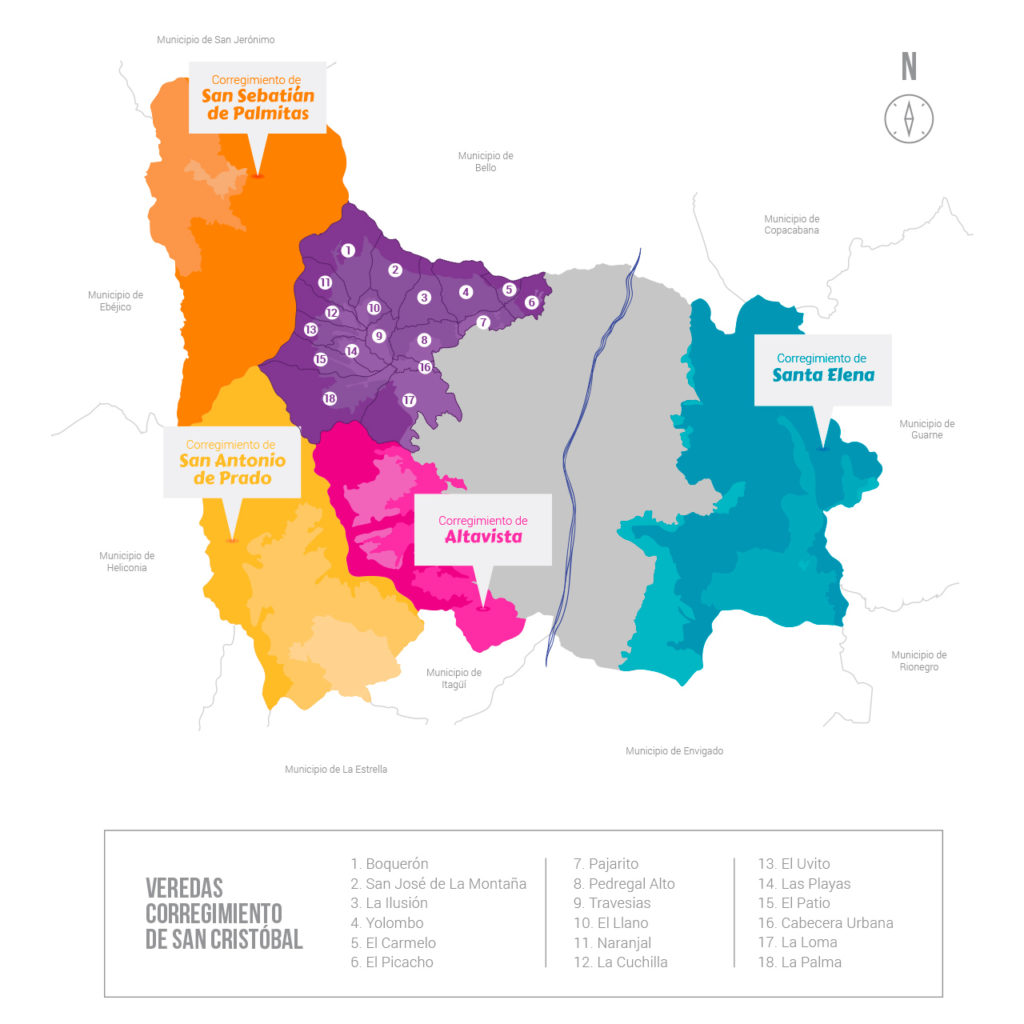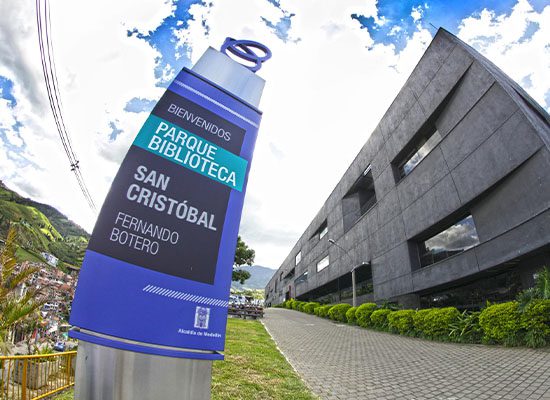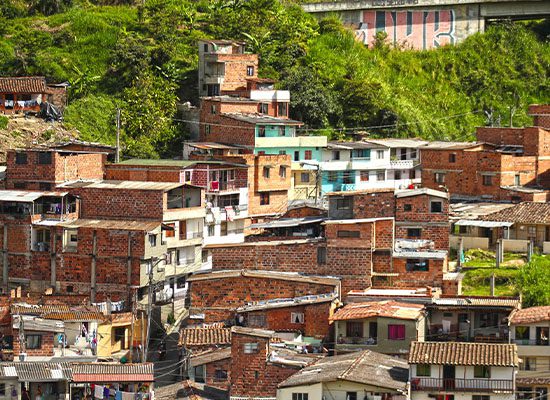San Cristóbal
The small town of San Cristóbal, the main producer of flowers and vegetables in Medellín, merges the rural and the urban due to its proximity to the city. Its landscape is particularly charming because it allows visitors to interact with the agricultural and flower crops to learn about the processes of planting, harvesting, and transportation.
The Flower Museum and the Cano Family’s Flower Farm are a reflection of the culture of the people of San Cristóbal as traditional flower growers. The museum has a collection of 300 species that can be appreciated during a tour to learn about the different types of flowers in the region and their care. The flower farm has a privileged view of the natural landscape of San Cristóbal, from which not only are the flower crops visible, but also the agricultural products that embellish the landscape. Fifty percent of the flowers grown in San Cristóbal are exported to Canada, the United States, and the Caribbean.
Hacienda Veracruz is also known for providing agrotourism services based on the traditions and sustainable farming practices, where you can learn first-hand about the cultivation of onions, cilantro, parsley, lettuce, spinach, among others.

Lookout Points of San Cristóbal
From the Cañón Santa Fe de Antioquia viewpoint, you can see the small town of San Sebastián de Palmitas and the municipalities of San Jerónimo, Santa Fe de Antioquia, and Sopetrán. This viewpoint is the highest in the small town and has some ecological trails through which you can enjoy the climate, flora, and fauna of the region.
The El Picacho lookout point is one of the most famous in Medellín and is an area for the conservation of fauna and flora, as well as a meeting point for the community and visitors. Currently, tourist activities such as hiking and birdwatching are available.
Fernando Botero Library Park
The Fernando Botero Library Park was founded on October 19, 2011, as a tribute to Fernando Botero, who donated the sculpture El gato and attended the inauguration of the library park in April 2012.
Where Is San Cristóbal and How to Get There?
Santa Cristóbal is a small town of Medellín located northwest of the city. It’s bordered on the east by the urban perimeter of the city, on the south by the small towns of Altavista and San Antonio de Prado, and on the west by the small town of San Sebastián de Palmitas.
It’s considered a strategic territory environmentally, as it contributes to the containment of urban sprawl, water conservation, soil protection, and especially forest cover.
Getting to San Cristóbal by Metrocable
To get to San Cristóbal by Metrocable, you need to get to San Javier station, which is the last station on Line B of the Medellín Metro, and take the cable to La Aurora station.
Getting to San Cristóbal by Bus
In Medellín, there are several bus routes that travel to San Cristóbal. You can take the integrated bus route to San Cristóbal from both San Javier Metro station and La Aurora Metrocable station.
You can also take a bus route towards the small town in La Alpujarra, Parque Berrío, and the Moravia neighborhood. Finally, also in La Alpujarra, you can take the bus route called San Cristóbal of the company Tax Maya.
Getting to San Cristóbal by Taxi
The distance from downtown Medellín to San Cristóbal is between 10 and 12 kilometers and the average cost of the taxi trip for 2020 is 20,000 COP (5.20 USD). The distance from the Laureles neighborhood is more or less the same and the average cost of the taxi trip for 2020 is 18,000 COP (4.68 USD). The distance from the El Poblado neighborhood, one of the most popular among visitors, is between 15 and 18 kilometers and the average cost of the taxi trip for 2020 is 28,000 COP (7.28 USD).
What to Do
Horacio Hoyos Zapata Suspension Bridge
This pedestrian bridge across the La Iguaná Stream has wooden structure, floor, and protective railings. Supported by steel wires anchored to four concrete columns at its ends, the bridge is notable as an exact replica of the Santa Fe de Antioquia suspension bridge.
San Cristóbal “Fernando Botero” Library Park
The San Cristóbal “Fernando Botero” Library Park is part of a master plan that centers around an architecturally distinctive building. This plan seeks to establish new cultural projects and services that will create a fresh dynamic in the small town, while addressing the most urgent social needs of its residents.
Monument to the Muleteer
The sculpture is a representation of all the farmers and their traditional activity in the history of the sector’s configuration. The sculpture became valuable since it was situated in a strategic place in relation to the surroundings. Originally made of clay, the statue is currently made of bronze. It’s located in the central square of the small town and, in general, it’s well preserved.
Flower Museum
This house museum is managed by its owner Mrs. Ofelia Correa who takes care of the 500 different species of flowers planted. She has received several awards for having a “very beautiful garden” as she calls it.
Doña Oliva Ortiz’s Old House
The house is approximately 110 years old. Although part of it has been reformed with adobe and tile and some windows and doors have been changed, the house had initially rammed-earth and bahareque walls and wooden windows and doors.
Miriam Sierra’s Old House
It was built with rammed earth and has been reformed with adobe and tiles. The house is in good condition, but is rented for housing and therefore is not available in any tourist plans.
El Corcel Stable
The house is in good condition and retains the aesthetic and structural elements of traditional local residential architecture with materials such as stone, bricks, and rammed earth.
Cemetery
Founded by the parish priest Jorge Alberto Toro, it’s the only cemetery in the small town. It’s built with brick, cement, and concrete and has an approximate area of 1300 meters. Its construction began in 1945 on land donated by the Moreno family and was inaugurated on February 28, 1965. It’s a representative site for the community, which is in a good state of preservation and provides a pleasant and peaceful environment. Its contemporary architectural structures create a good balance between space and volume.
Cultural Center
The Luis Eduardo Maya Cultural Center focuses its activities on the development of the community’s artistic skills. The center has held several art events, such as exhibitions of nativity scenes, which highlight the talent of the small town’s inhabitants.
San Cristóbal Parish Church
The San Cristóbal parish was founded in 1771. The construction of the church was encouraged by Father Ramón María Gómez and Nepomuceno Morales. The church has a republic style, rammed-earth lateral walls, and central adobe columns. Inside the church, besides other images, there’s an oil painting of Saint Christopher which is approximately 200 years old.
Cristo de las Misericordias Sanctuary
The sanctuary was inaugurated on July 25, 1935, by Father Ignacio Gómez. It has concrete images of the Divine Mercy, the Virgin of Sorrows, Saint John, Mary Magdalene, and the Angel of Silence looking at the people. Previously, the sanctuary was located next to the church, but, due to the construction of the Túnel de Occidente, it was moved to a small hill about 15 minutes from the small town by foot.
El Carmelo Chapel and Monte Alvernia Meeting House
As director of the Monte Alvernia meeting house from 1999 to 2002, Hernando Arias Rodríguez led the restoration of the house founded in 1902. In that way, the meeting house could continue benefiting the community. The chapel is also a spiritual epicenter of the rural settlement of El Carmelo, Yolombó, Sabana Larga, and Jalisco, the latter two belonging to the municipality of Bello.
San Juan Bosco Chapel
The chapel was consecrated in honor of Saint John Bosco by Monsignor Gilberto Jiménez, auxiliary bishop of Medellín. Its construction began in June 2003 by people from the small town. Generally, there are no outstanding characteristics in its structure or spatial management. However, one notable feature is a cross that stands out for its formal qualities, as it’s part of the vertical volume that functions as the bell tower.
Old Houses
Although they refer to a group of buildings, most of them don’t exist today. The only one that is still standing is the La Asomadera house, which was built with traditional construction materials. However, the house has been modified and part of its facade is in a certain state of deterioration.
Nuestra Señora de los Desamparados Parish Church
The church was built 32 years ago. Initially, it was called San José de la Montaña and, seven years ago, it was declared as Parroquia Nuestra Señora de los Desamparados. The parish serves the rural settlements of San José de la Montaña, Boquerón, La Ilusión, and Yolombó.
San Gerardo María Máyela Redemptorist Missionary Seminary
This seminary currently houses young catechumens who are studying to become priests of the Catholic Church.
El Rancho del Tigre Cockpit
The cockpit has been in operation for 12 years and is owned by Mr. Ángel Augusto Pérez. It’s open to the public every fifteen days to hold cockfighting matches. Gamecocks are weighed and attached spurs on their legs, and people bet on their favorite.
La Loma “San Vicente Ferrer” Church
The church is situated on land donated by Francisco Pizarro (a.k.a. Panchito). It was founded on April 5, 1961, on the day of Saint Vincent Ferrer, and its first parish priest was Luis López de Mesa.
El Llano “Nuestra Señora del Camino” Church
Located in the rural settlement of El Llano, this church is visited on weekends, mainly by pilgrims from the area.
Flower Cultivation
San Cristóbal has a long tradition of growing flowers of various species, such as goldenrods, Dutch irises, chrysanthemums, Mexican sunflowers, houseleeks, amaranths, calla lilies, daisies of different colors, China roses, foliage, lilies of the Nile, and yellow roses. Crops can be found in rural settlements such as La Ilusión and El Llano and the urban area of the small town. These flowers are sold in different areas of Medellín and are also used to decorate the silletas for the traditional Silleteros’ Parade.
Greenhouse and Open-Field Flower Cultivation
In the small town overall, and especially in the rural settlement of La Cuchilla, flower cultivation—both in greenhouses and in open fields—is an important tradition. Notable farms include those of Mr. Isidro de Jesús Restrepo, Pablo Emilio Cano, and Flores La Colina, which are located 20 to 25 minutes by car from the central square. Main species grown include goldenrods, white asters, snapdragons, pom-pom chrysanthemums, and daisies.
Vegetable Crops
San Cristóbal is characterized by its vegetable crops. However, since there are densely populated areas limiting the land available for cultivation, these crops are distributed in small plots, where small-scale productive activity alternates with the daily life of the residents. Furthermore, intensive exploitation of the soil is evident with practices such as monoculture.
El Tambor Bathing Place
Covered by native vegetation, El Tambor is a natural bathing spot in the La Iguaná stream. It’s located at the foot of several houses and a bridge whose design is unsuited to the natural surroundings. That’s why locals recommend using it with caution. The site lacks biodiversity, offers limited scenic views, and its flora and fauna have been impacted by frequent human presence.
La Iguaná Stream
The La Iguaná stream originates in the rural settlement of Boquerón in the Alto de las Baldías at an elevation of 2950 meters in the spurs of Alto de las Repetidoras. The stream runs through the rural settlements of El Llano, El Naranjal, La Cuchilla, El Uvito, and Las Playas and through the central part of San Cristóbal, creating dividing lines between some of these rural settlements. It flows into the Medellín River at an elevation of 1453 meters. The stream has good environmental conditions in its upper part, which diminish as it enters the urban landscape.
Cueva del Indio
This cave is located in the upper part of the rural settlement of Boquerón, on the border with the small town of San Félix in the municipality of Bello. The access to the cave is through roads of a private farm dedicated to dairy and pork production. According to the inhabitants of the area, the Cueva del Indio connected the rural settlements of Boquerón and La Ilusión. Curiously, and at first glance, the Cueva del Indio looks like a small cave built by an animal. While the landscapes and views of the site are very attractive, there is no representative natural wealth of fauna and flora.
Loma de la Pereza Forest
Found in the rural settlement of La Palma, the Loma de la Pereza forest is a very important natural reserve for its abundant native flora and fauna. This forest is the source of the La Francisca stream, which, together with the La Palma stream, supplies the aqueduct La Acuarela. These streams are born in the Padre Amaya hill, at an elevation of around 3,050 meters. The aqueduct supplies water to the rural settlements of Bellavista, Travesías, San José, La Palma, El Patio, and Las Playas.
Alto del Moral
The Alto del Moral is located in the upper part of the rural settlement of La Palma. Thanks to its small wetland, the hill is a strategic ecosystem that is currently a source of food for wildlife and the livestock of some families who live nearby. Hydrophytic plants found in the wetland store and release water through their tissues, thus carrying out an essential filtering process for the habitat.
La Cenón and San Francisca Streams
The La Cenón and San Francisca streams are natural attractions that cross the rural settlement of La Palma in a segment full of native vegetation and breathtaking landscapes. La Cenón is a tributary of the San Francisca stream, as well as the El Chorro, La Laguna, El Morral, and El Cañón de la Loma de la Pereza streams. The San Francisca stream flows into the La Iguaná stream in the limits of the rural settlement of El Llano. In some parts, the natural course of the stream is diverted so that it crosses man-made constructions, and in other parts, its environment is degraded as a result of fires and modifications of the alluvial plains.
Los Indios Lookout Point
The Los Indios Lookout Point is near an important road system for vehicles traveling towards the coastal and agro-industrial zone of Urabá, making it a passing territory between the Valle de Aburrá and the Cauca River. The place has native trees that help purify the water and a beautiful panoramic view, but not much diversity of fauna.
La Lejía Waterfall
The La Lejía stream descends from the mountain range that crosses the Padre Amaya hill, in which three tributaries flow. These three sources of water form three steep falls that delight visitors with such stunning scenery. Surrounded by native trees and plants, the waterfall invites you to take deep breaths of fresh air.
El Moral Lagoon
The El Moral lagoon is found in the upper part of the rural settlement of La Palma. It’s a strategic ecosystem that is currently a source of food for wildlife and the livestock of some families near the hill. The lagoon is close to Alto del Moral, both of which are places modified by human action. The lagoon sets this place apart from others in the area.
Artesanías Las Playas
Dedicated to producing handmade money boxes and pots in various shapes, this company began operations 12 years ago under the administration of Mr. William Moreno. The owners of the company are natives of the small town of San Cristóbal and they are also the artisans. The handmade brick oven stands out as the most representative element of the place.
Information for Tourists
The following grassroots initiatives or organizations can assist you with tourism services in the small town of San Cristóbal:
Truchera Boquerón – Nature Tourism, Ecotourism, and Agrotourism:
+57 604 4275336 Juan Diego Uribe
+57 310 3580094 Diana Hincapié
Truchera Norilandia – Agrotourism:
+57 604 4271579 Hernando Moreno
Finca La María – Event Organization:
+57 3122280688 Yesid Sánchez
Guianzas Turísticas San Cristóbal – Tourist Guide:
+57 604 4271461 Martha Herrera
Terracultura S.A.S – Tourist Guide and Event Organization:
+57 3112730215 Alba Nora Sánchez
+57 3145085557 Luis Eber Salazar
Recommendations
- Bring a tourist map of the small town and find out about the topographical and climatic conditions of the areas you plan to visit. In addition, make a copy of your passport, medical assistance card, and other documents.
- Use sunscreen even if it’s cloudy or sunless. Wear comfortable shoes and warm clothes, especially in the afternoon and at night, as the temperature can drop considerably.
- Since it’s a rural environment, you may have to be prepared for long walks; proper food and hydration will allow you to be on your feet during the whole route.
- Enjoy forests, lakes, historic roads, farms, and other spaces responsibly. Don’t leave your litter in these places or damage the flora and fauna of the territory.
- Invest in the territory, support local businesses by buying their products, and try to contribute to the development of sustainable and responsible tourism.
- In addition to a camera with enough space, bring binoculars to closely observe the flora and fauna found in the area.
Through the Buy Local initiative you can support the ventures of producers, farmers and artisans from the districts of Medellín.








